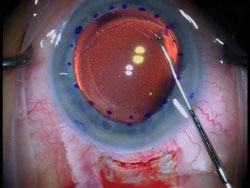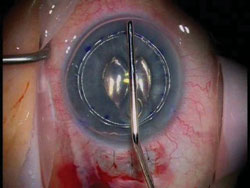Hyperopic shift stabilizes 6 to 12 months after DSAEK, study shows
Refractive stability was largely attributed to a horizontal wound that does not require suturing.
 Edwin S. Chen |
Descemet’s stripping automated endothelial keratoplasty yielded more stable long-term refraction than penetrating keratoplasty, according to a study.
Data showed that a hyperopic refractive shift after DSAEK is stable between 6 and 12 months.
“The prescription that people will require after this kind of surgery is stable as soon as 6 months after surgery, on average,” Edwin S. Chen, MD, the lead study author, said in an interview with Ocular Surgery News.
The study was the first to assess refractive stability more than 6 months after DSAEK in a group of patients specifically selected for accuracy of preoperative refraction, the authors said.
PK typically results in unpredictable long-term refractive outcomes, Dr. Chen said.
“The refractive error that patients had could shift for months to years after the procedure was finished, so we never really knew when our best vision was going to be,” he said. “It would take up to a couple of years until that would occur, whereas with [DSAEK], that stability is achieved much sooner.”
Dr. Chen and colleagues reported their findings in correspondence to the Journal of Cataract and Refractive Surgery.
Preop accuracy, postop stability
The prospective study included 34 eyes that underwent DSAEK for Fuchs’ endothelial dystrophy or pseudophakic bullous keratopathy. Inclusion criteria were designed to filter out patients with an irregular corneal refracting surface or poor preoperative vision, which would compromise the accuracy of preoperative manifest refraction.
 Stripping of Descemet’s membrane. |
 Graft is well-centered in the eye. Images: Terry MA |
“In this study, we specifically selected people in whom we felt the preoperative refraction was accurate,” Dr. Chen said. “That, I think, is important because when you’re not sure about your initial measurements, the accuracy of the difference between your first measurement and your second measurement is in jeopardy. … The confidence of the preoperative refraction is important for how clinically significant these findings are.”
Preoperative mean spherical manifest refraction was –0.13 ± 1.31 D. At 6 months, mean manifest refraction was +0.87 ± 1.14 D. The hyperopic shift of +1 D over 6 months was statistically significant (P < .001).
Among 22 patients for whom 12-month data were available, mean preoperative manifest refraction was –0.02 ± 1.11 D. These patients’ mean manifest refraction at 12 months was +0.97 ± 0.97 D. The hyperopic shift of +0.99 D over 12 months was statistically significant (P < .001).
Among 18 eyes that reached 6-month and 12-month data collection points, mean manifest refraction was +0.86 ± 0.92 D at 6 months and +1 ± 1.06 D at 12 months. The 0.14 D difference was not statistically significant, the authors said.
Horizontal, sutureless incision
Long-term refractive stability may be attributed to wound architecture and stability, Dr. Chen said, adding that the horizontal wound does not require sutures, which is a relevant factor.
With PK, the vertical wound design typically shifts over time and causes a refractive shift.
“The major factor here is that the wound in this procedure does not require suture closure of the wound for the corneal graft, whereas for a PK, you typically have between 12 and 24 stitches,” he said. “As those stitches loosen or come out, the wound is tighter or looser in various areas.”
Additionally, none of the patients needed to undergo further refractive procedures to correct high postoperative astigmatic errors.
“That’s one thing that distinguishes this from PK,” Dr. Chen said. “This procedure has a minimal amount of induced astigmatism in contrast to PK. It’s very common for people after PK to require multiple surgical procedures to help to remedy that.”
The role of donor graft tissue factors has not been examined in relation to refractive stability. “That’s something that we have not yet looked into at this point, but may in the future,” he said.
Follow-up with the same patient group is expected to extend 2 to 5 years after surgery.
“By then, we should know for sure when this is truly stable,” Dr. Chen said. “I would suspect that what we have at 6 and 12 months is probably what we’re going to end up with.” – by Matt Hasson
Reference:
- Chen ES, Terry MA, Shamie N, Hoar KL, Friend DJ. Stability of hyperopic refractive shift following Descemet-stripping automated endothelial keratoplasty. J Cataract Refract Surg. 2009;35(8):1473.
- Edwin S. Chen, MD, can be reached at Wills Eye Cornea Service, 840 Walnut St., Philadelphia, PA 19107; 866-337-7167; fax: 215-928-3854; e-mail: eschen37@hotmail.com.

